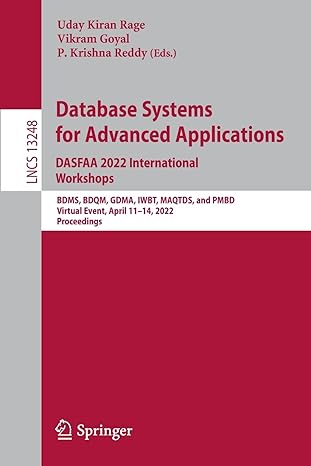Question
1. What are the four main functions of a computer? 2. List and briefly define the main structural components of a computer. 3. List and
1. What are the four main functions of a computer? 2. List and briefly define the main structural components of a computer. 3. List and briefly define the main structural components of a processor. 4. Explain Moores Law. 5. List and explain the key characteristics of a computer family. 6. Given the memory contents of the IAS computer shown below:
Address Contents 08A 010FA210FB 08B 010FA0F08D 08C 020FA210FB
Show the assembly language code for the program, starting at address 08A. Explain what the program does. 7. What general categories of functions are specified by computer instruction? 8. In a computer, what is a bus, and what does it connect? 9. What is the maximum directly addressable memory capacity in bytes, if the address bus is 16- bit? Assume each memory location is one byte. 10. Consider a hypothetical 32-bit microprocessor having 32-bit instructions composed of two fields, the first byte contains the opcode and the remainder is the operand address. a. What is the maximum directly addressable memory capacity in bytes? Assume each memory location is one byte. b. How many bits are needed for the program counter and the instruction register? 11. Briefly define the following states of an instruction execution as shown in Figure 3.6. a. Instruction address calculation b. Instruction fetch c. Instruction operation decoding d. Operand address calculation e. Operand fetch f. Data operation g. Operand store
12. The hypothetical machine of Figure 3.4 has two I/O instructions:
0011 = Load AC from I/O 0111 = Store AC to I/O
In these cases, the 12-bit address identifies a particular I/O device. Show the program execution (using the format of Figure 3.5) for the following program: 1. Load AC from device 5. 2. Add contents of memory location 940. 3. Store AC to device 6.
Assume that the next value retrieved from device 5 is 3 and that location 940 contains a value of 2.
13. Count from 1 to 2010 in the following bases: a. 8, b. 5 14. Convert the following binary numbers to their decimal equivalent: a. 11100.011 b. 110011.10011 15. Convert the following decimal numbers to their binary equivalent: a. 34.75 b. 27.1875 16. Convert the following hexadecimal numbers to their decimal equivalent: a. F.4 b. D3.E 17. Convert the following decimal numbers to their hexadecimal equivalent: a. 204.125 b.631.25 18. Represent the following decimal numbers in both sign/magnitude and twos complement using 16 bits: +512, -29 19. Represent the following twos complement values in decimal: 1101011; 0101101 20. Assume numbers are represented in 8-bit twos complement representation. Convert to binary and show the calculation. Also indicate if the operation results in a carry bit, and/or if it is a case of overflow. a. 6 + 13 b. -6 + 13 c. 6 13 d. -6 - 13 21. Find the following differences using twos complement arithmetic. Also indicate if the operation results in a carry bit, and/or if it is a case of overflow. a. 111000 b. 11001100 c. 111100001111 d. 11000011 - 110011 - 101110 - 110011110011 - 11101000 22. Perform the following operations of unsigned integers in Binary: 1001 (9) 110110110111 x 1011 (11)
Step by Step Solution
There are 3 Steps involved in it
Step: 1

Get Instant Access to Expert-Tailored Solutions
See step-by-step solutions with expert insights and AI powered tools for academic success
Step: 2

Step: 3

Ace Your Homework with AI
Get the answers you need in no time with our AI-driven, step-by-step assistance
Get Started


